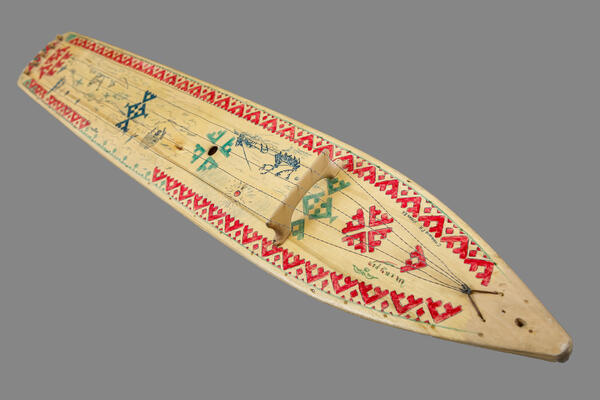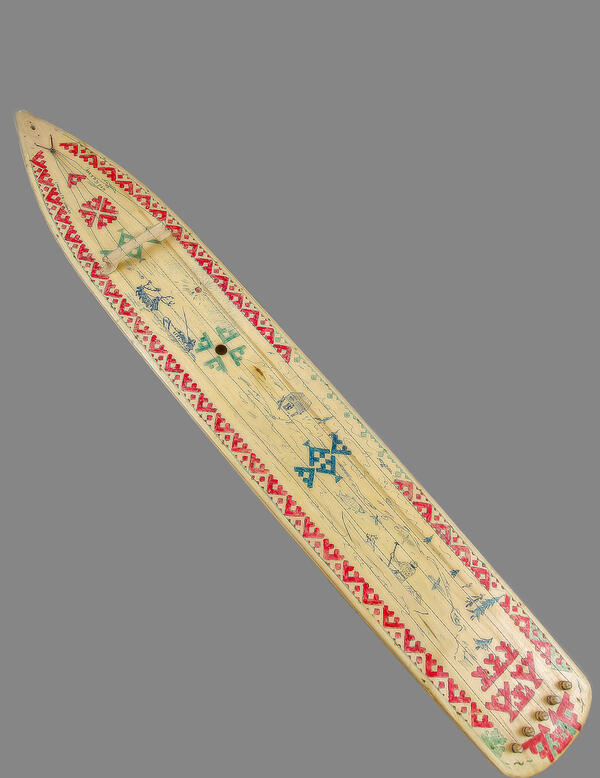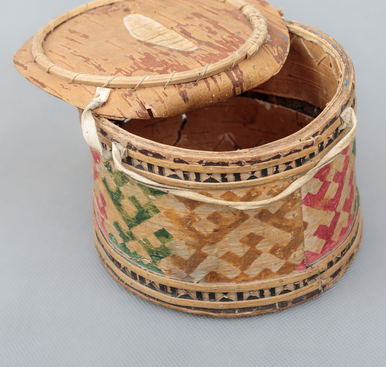A sankvyltap (or sangultap, also sangul’tap) is a folk stringed musical instrument of the Ob Ugrians — the peoples of the Khanty and Mansi. The sankvyltap was used both in cult practices and simply for playing music.
The instrument was made from the trunks of cedar, spruce or aspen — artisans made it in the shape of a boat or fish. In fact, a sankvyltap is a plank zither with a resonator with a soundboard put on top. It had three, five or seven strings. In its original form, the strings were created from the intestines or tendons of a deer.
Only men played this instrument, sitting on their legs folded crosswise. During the performance, the sankvyltap was kept on the knees in a horizontal position, slightly tilted to one side. Playing the instrument consisted of plucking the strings with one hand and muting them with the other. Raising the strings above the soundboard of the instrument was achieved using a special stand, which was located approximately 25–30 cm from the rounded edge of the instrument.
In order to strengthen the body and especially its upper deck, artisans installed a kind of frame inside the sankvyltap, which also made it possible to improve resonation. Inside the instrument, it was customary to pour salt, shot, put stones, glass or metal plates, which were supposed to rattle when the musician shook the instrument while playing.
The instruments could vary in size: some reached 130 cm in length and 27 cm in width, others could be half as large. The most common instruments were 90–100 cm long and 15–20 cm wide. The height or “depth” of the body of the sankvyltap was 5–7 cm, although there were also “deeper” ones.
In the instruments of the Khanty and Mansi, the higher strings were located below, and the lower strings were located on top of the sankvyltap, approximately where its inner side surface was located in the instrument of the Balto-Finns.
The sankvyltap from the collection of the Uray City Historical Museum is light yellow. It is decorated with a traditional red and green pattern called “hare ears”. Currently, the sankvyltap is sometimes used in amateur performances. And if earlier only men played it, now women can also use this instrument.
The instrument was made from the trunks of cedar, spruce or aspen — artisans made it in the shape of a boat or fish. In fact, a sankvyltap is a plank zither with a resonator with a soundboard put on top. It had three, five or seven strings. In its original form, the strings were created from the intestines or tendons of a deer.
Only men played this instrument, sitting on their legs folded crosswise. During the performance, the sankvyltap was kept on the knees in a horizontal position, slightly tilted to one side. Playing the instrument consisted of plucking the strings with one hand and muting them with the other. Raising the strings above the soundboard of the instrument was achieved using a special stand, which was located approximately 25–30 cm from the rounded edge of the instrument.
In order to strengthen the body and especially its upper deck, artisans installed a kind of frame inside the sankvyltap, which also made it possible to improve resonation. Inside the instrument, it was customary to pour salt, shot, put stones, glass or metal plates, which were supposed to rattle when the musician shook the instrument while playing.
The instruments could vary in size: some reached 130 cm in length and 27 cm in width, others could be half as large. The most common instruments were 90–100 cm long and 15–20 cm wide. The height or “depth” of the body of the sankvyltap was 5–7 cm, although there were also “deeper” ones.
In the instruments of the Khanty and Mansi, the higher strings were located below, and the lower strings were located on top of the sankvyltap, approximately where its inner side surface was located in the instrument of the Balto-Finns.
The sankvyltap from the collection of the Uray City Historical Museum is light yellow. It is decorated with a traditional red and green pattern called “hare ears”. Currently, the sankvyltap is sometimes used in amateur performances. And if earlier only men played it, now women can also use this instrument.




